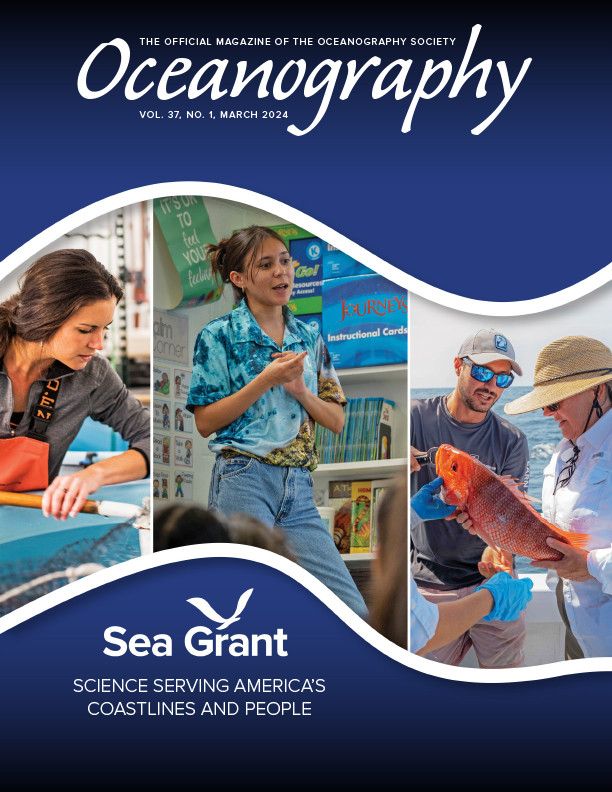Introduction
Coastal communities across the United States face growing challenges, especially as climate change increases the risks associated with coastal hazards and weather extremes (May et al., 2023). To effectively confront this challenge, government and decision-makers across multiple sectors and scales are working to assess those risks and develop adaptation strategies, activities, and projects. These adaptation steps can be framed as part of an adaptation cycle (National Research Council, 2010; Figure 1) and can include planning for infrastructure upgrades, evaluating the vulnerability of public services and assets, monitoring coastal damages, and restoring natural habitats that help buffer or protect the shoreline. Collectively, these steps (hereafter referred to as “adaptation”) enable communities to reduce risks associated with extreme weather events and coastal hazards and enhance the resilience of coastlines and people.
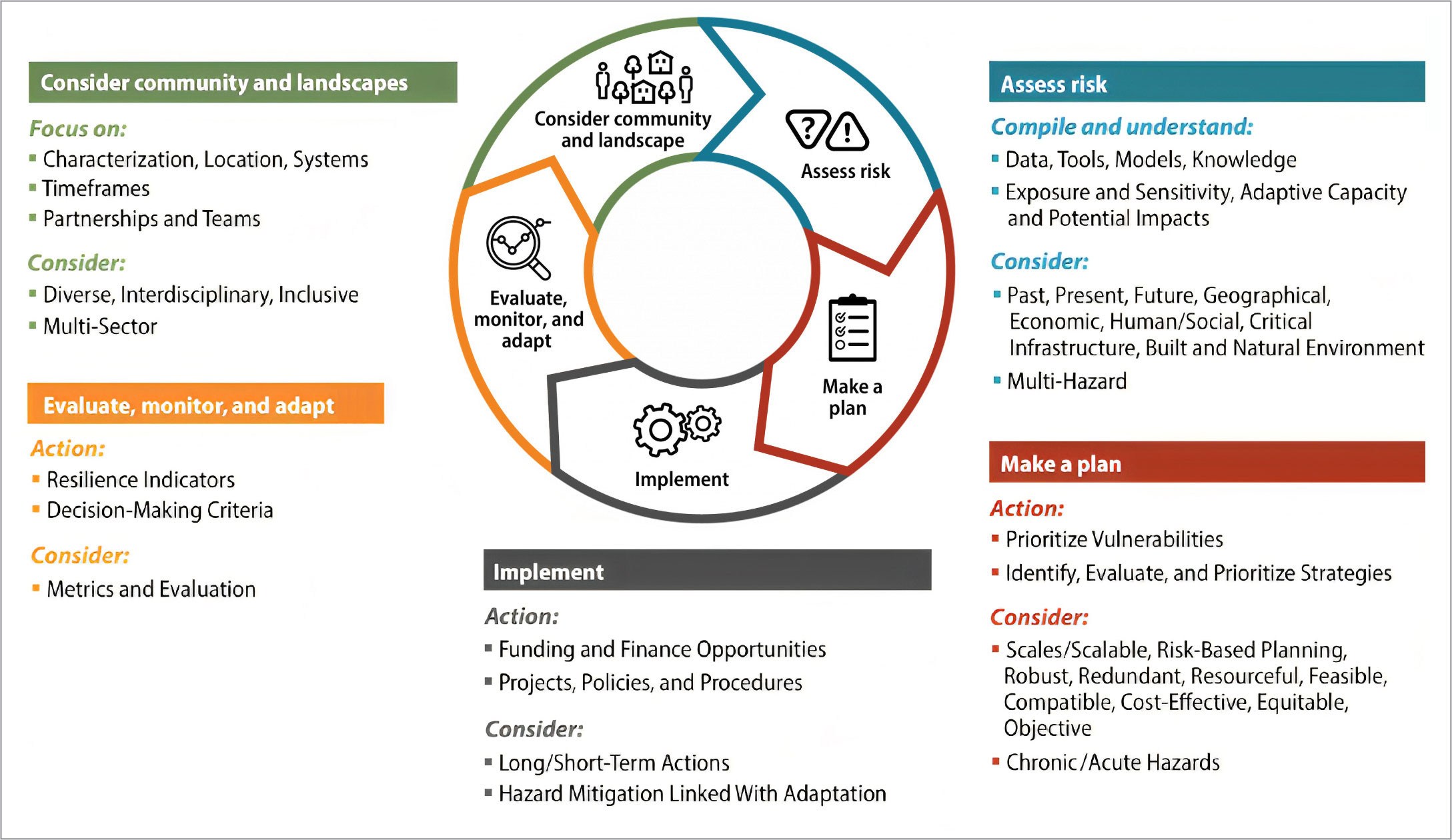
FIGURE 1. An example adaptation cycle illustrates the multiple steps, inputs, and considerations that may be required to adapt to the impacts of climate change on communities and coasts. Figure used by permission from the Maine Climate Change Adaptation Providers Network as developed by the Maine Department of Environmental Protection and Maine Sea Grant. > High res figure
|
Adaptation in coastal communities is associated with significant challenges (Eisenack et al., 2014). Implementing adaptation steps (Figure 1) can often be complex, costly, and require a diverse set of technical skills and expertise. For example, designing and gaining community buy-in for adaptation strategies may require integrating coastal and climate change science with legal, land use, and equity considerations as well as cultural values important to communities. To do this effectively, communities often need, but frequently lack, specialized support in risk communication, coastal land use policy and law, financing and economic evaluation, and community engagement, particularly when engaging diverse or frontline populations (frontline populations are those that experience the “first and worst” consequences of climate change). In the last two decades, Sea Grant has expanded its efforts to assist coastal communities with adapting to hazards and extreme weather (Whitehead et al., 2018) by serving as intermediaries and trusted partners and working across sectors and disciplines to facilitate and build capacity for climate adaptation.
This article distills the expertise of its authors, many of whom have multiple years or decades of experience within the Sea Grant network, to identify a set of strategies that facilitate the process of adaptation in vulnerable communities. We then summarize current Sea Grant projects and activities to demonstrate how the application of those strategies leads to adaptation activities and projects, and we conclude with a discussion of emerging challenges and recommendations for bolstering Sea Grant’s capacity to continue supporting adaptation.
Five Sea Grant Strategies that Support Adaptation
Five strategies (Figure 2) enable Sea Grant professionals and programs to effectively build the resilience of the nation’s coastal communities. Many of these strategies are not exclusive to adaptation but are employed across Sea Grant programs to address a variety of marine and coastal stressors. Indeed, many of these strategies are rooted in Sea Grant’s legacy of academic extension and are recognized as effective in addressing many of the challenges that extension confronts (Cash, 2001; Bednarek et al., 2018).

FIGURE 2. The five strategies shown here are employed by Sea Grant to advance adaptation in coastal communities. Blue circles represent individual Sea Grant programs, while yellow circles represent the over 2,700 partners and communities with whom they collaborate. Figure by Mary Collins, National Sea Grant Office. > High res figure
|
Strategy 1: Place-Based People and Programs
Sea Grant programs, most housed within universities, place staff within communities in the states that they serve (Figure 3). This intentional distribution of professionals and program resources enables Sea Grant to build deep-rooted partnerships with scientists, practitioners, and community members. This place-based strategy provides Sea Grant professionals with a deep awareness of community needs, an ability to tap into and leverage local knowledge, and an understanding of culture and values. It also enables Sea Grant to identify and support initiatives that are more likely to generate meaningful adaptation and resilience and better serve the community.
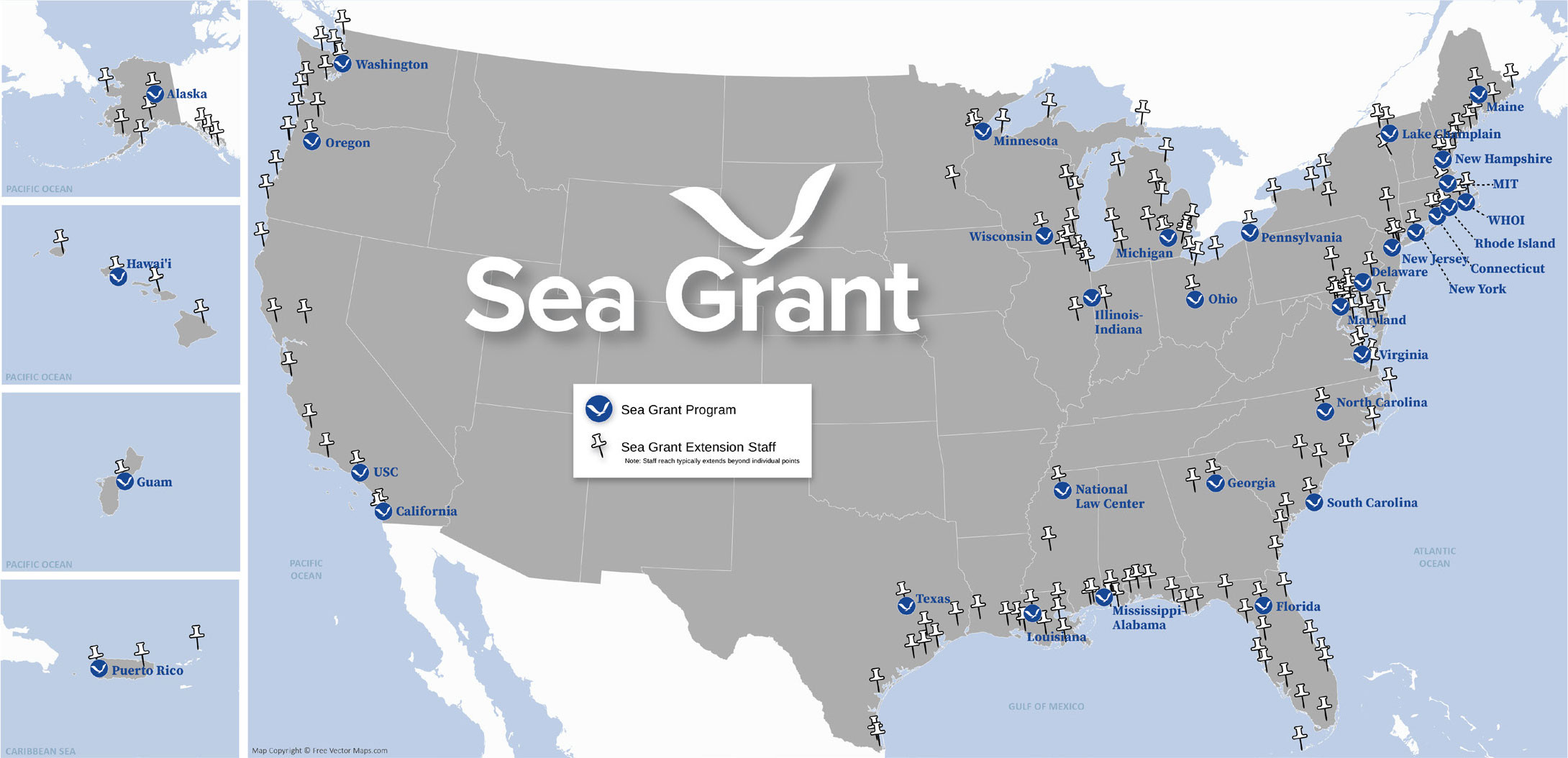
FIGURE 3. This map is a visualization of the geographically dispersed and community-embedded Sea Grant network, comprising 34 programs across the nation and over 800 extension staff, many of whom are sited away from their program headquarters. Courtesy of the National Sea Grant Office, 2023. > High res figure
|
Strategy 2: Continuous Engagement
Sea Grant programs and staff invest continually in building community partnerships. This allows Sea Grant to work with collaborators beyond the timeframes of funded projects or contracts. Continuous engagement builds relationships and facilitates the maintenance of partnerships and networks that can be poised to take advantage of opportunities that arise in an evolving funding and political landscape. The maintenance of relationships that this strategy facilitates is particularly important in frontline communities and groups that have been traditionally underserved and are socially vulnerable. Within these communities there can be complex and sometimes tenuous relationships with government agencies or academic researchers. Continuous engagement builds durable connections between Sea Grant programs and communities that can lead to improved access to hazard and climate adaptation services and facilitate direct relationships with researchers and technical experts.
Strategy 3: Boundary-Spanning
Sea Grant programs encourage development of interdisciplinary expertise within staff and teams that fosters an ability to work across sectors, disciplines, and even cultures. The extension model that dates to the late 1800s in the United States and territories is, in many ways, built on this concept (Lubell et al., 2014), with its emphasis on professionals, sometimes also referred to as “specialists,” who can operate effectively across traditionally siloed academic and industry sectors. Many Sea Grant staff have advanced degrees in climate science, oceanography, coastal hazards, policy, planning, communications, and a variety of other disciplines. They also develop facilitation skills and cultural competencies that support community engagement. This strategy enhances the ability of Sea Grant programs to convene people across entities and sectors, interpret science for local planning integration, and identify mutually beneficial approaches to building effective climate adaptation projects and networks (Figure 4).
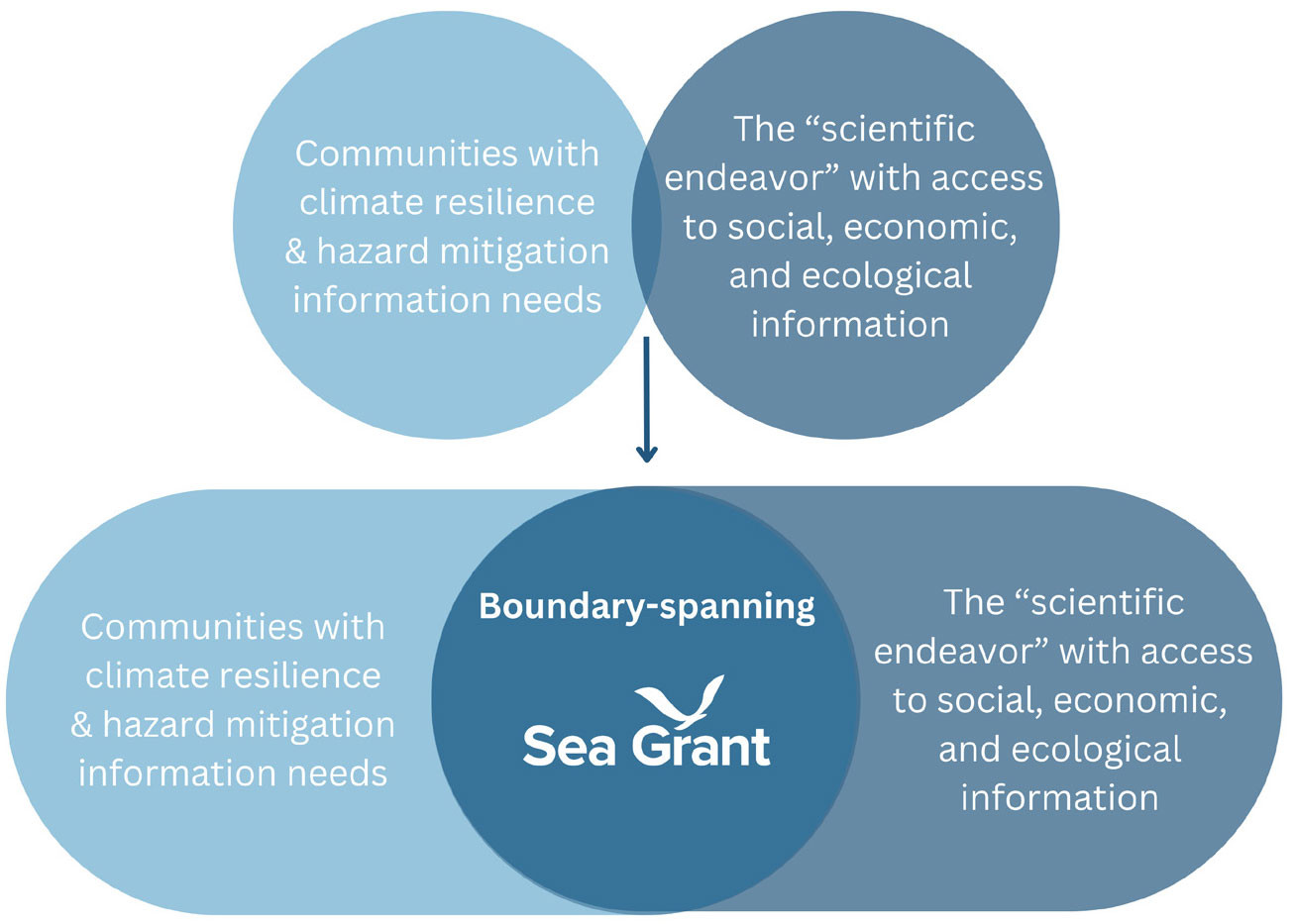
FIGURE 4. A conceptual model for boundary-spanning that enhances the interactions between communities and academic/federal science to support community climate resilience. Figure modified from Moon et al. (2020) and courtesy of Mary Collins, National Sea Grant Office. > High res figure
|
Strategy 4: Diversified Program Capacity
Many Sea Grant programs intentionally develop a diverse assemblage of in-house capacities to complement their science funding and extension functions, which may include legal and policy support, and communication and education services. Sea Grant programs also create capacity through external partnerships, for example, liaison positions with agencies such as the Department of Defense and NOAA, one-year fellowships placed at state or federal government entities, and co-funded positions with local governments and tribes. These positions serve to enhance access to specialized and diverse resources and expertise that can be leveraged for addressing the multi-faceted challenges associated with adaptation and building coastal and community resilience.
Strategy 5: Research to Solve Problems
Knowledge about local science and ecology is critical for understanding and adapting to coastal hazards and extreme weather. Sea Grant emphasizes “research with a purpose” both through the work of Sea Grant specialists, many of whom are active within scientific disciplines, and through their research funding programs. This strategy facilitates science that informs management, decision-making, and project development in a variety of ways, for example, science translation services and specialized communication products that enhance the use of technical information by non-technical or non-specialized audiences, “co-production” of science that is directly informed by community priorities and needs, and filling science gaps to address interdisciplinary or societal needs (Foley et al., 2020).
From Strategy to Action
By leveraging these five strategies, Sea Grant programs are positioned to improve communication and collaboration that accelerate adaptation and produce inclusive and effective hazards and climate research, policy, and technical assistance for communities at risk. The following summaries of example Sea Grant activities and projects illustrate how these five strategies lead to adaptation across the United States and territories.
Providing Accessible Insights to Partners
Sea Grant’s place-based people and programs and continuous engagement yield insights about the scientific information needed to answer critical community questions. Sea Grant programs frequently engage in or fund applied science, but emphasize the application of the results in management contexts as much as, or more than, traditional publication of results in scientific journals. Furthermore, the diversified program capacity of Sea Grant programs helps to quickly create science, policy, and law translation products or training that enable audiences to digest and use this information in a way that discipline-specific technical publications often cannot.
As an example, many Sea Grant programs leverage their partnerships, scientific expertise, and communications capacities to develop, publish, and disseminate customized, science-based, and culturally appropriate products that provide coastal communities with the information they need to adapt to climate change. The Homeowner’s Handbook to Prepare for Natural Hazards, now in its fourth edition (https://seagrant.soest.hawaii.edu/homeowners-handbook-to-prepare-for-natural-hazards/), was originally developed in 2007 by Hawai‘i Sea Grant to promote resilience to climate-related hazards and extreme weather within Hawai‘i’s coastal communities. This resource provides practical advice for homeowners on how to protect their property from coastal hazards in their area and is available in easy-to-access print and electronic formats. The handbook has also been modified for use by at least 11 other Sea Grant programs, including those in Mississippi-Alabama, Delaware, Alaska, Massachusetts, Florida, Georgia, Virginia, Connecticut, Maine, Texas, and Rhode Island.
Many Sea Grant programs develop regionally relevant science translation and communication products that facilitate planning for sea level rise. In Hawai‘i, Sea Grant staff were instrumental in developing a customized sea level rise viewer that provided fine-scale, locally relevant flooding exposure, erosion models, and associated social and economic vulnerabilities. The viewer led to updates of coastal zone management strategies and a new policy requiring disclosure of sea level rise risk when selling property. The success of the viewer has prompted similar efforts in other locations, such as American Samoa. The Washington Coastal Resilience Project, led by Washington Sea Grant, similarly developed down-scaled sea level rise information that helped to enhance the credibility of projections and motivate sea level rise planning. The Mississippi-Alabama Sea Grant Consortium engages towns and cities in assessing their vulnerability to climate-related coastal hazards using the Coastal Resilience Index, which couples sea level projections and hazards science with local knowledge about coastal assets. The Coastal Resilience Index has been adapted for use by managers in several sectors including fisheries, tourism, ports, and oyster aquaculture, and similar efforts are now underway in many other Sea Grant programs.
Gathering, Connecting, and Convening
Sea Grant programs often emphasize building relationships and developing networks, thereby bringing together perspectives, opinions, and insights in ways that can yield new approaches to problems. This role is often a natural outcome of the boundary-spanning strategy, in the sense that Sea Grant professionals are often network nodes connecting people across geographies, disciplines, and sectors (Figure 5). At the same time, the act of connecting and convening facilitates the research for a purpose strategy, in that communication and relationship building between different sectors and disciplines can lead to new insights and connections, and ultimately new projects, new collaborations, and new initiatives. It is worth emphasizing that these connections and collaborations are not unidirectional; gatherings of scientists and coastal planners, for example, can inform the practices of coastal planners while also changing the direction or focus of research among the scientific community.
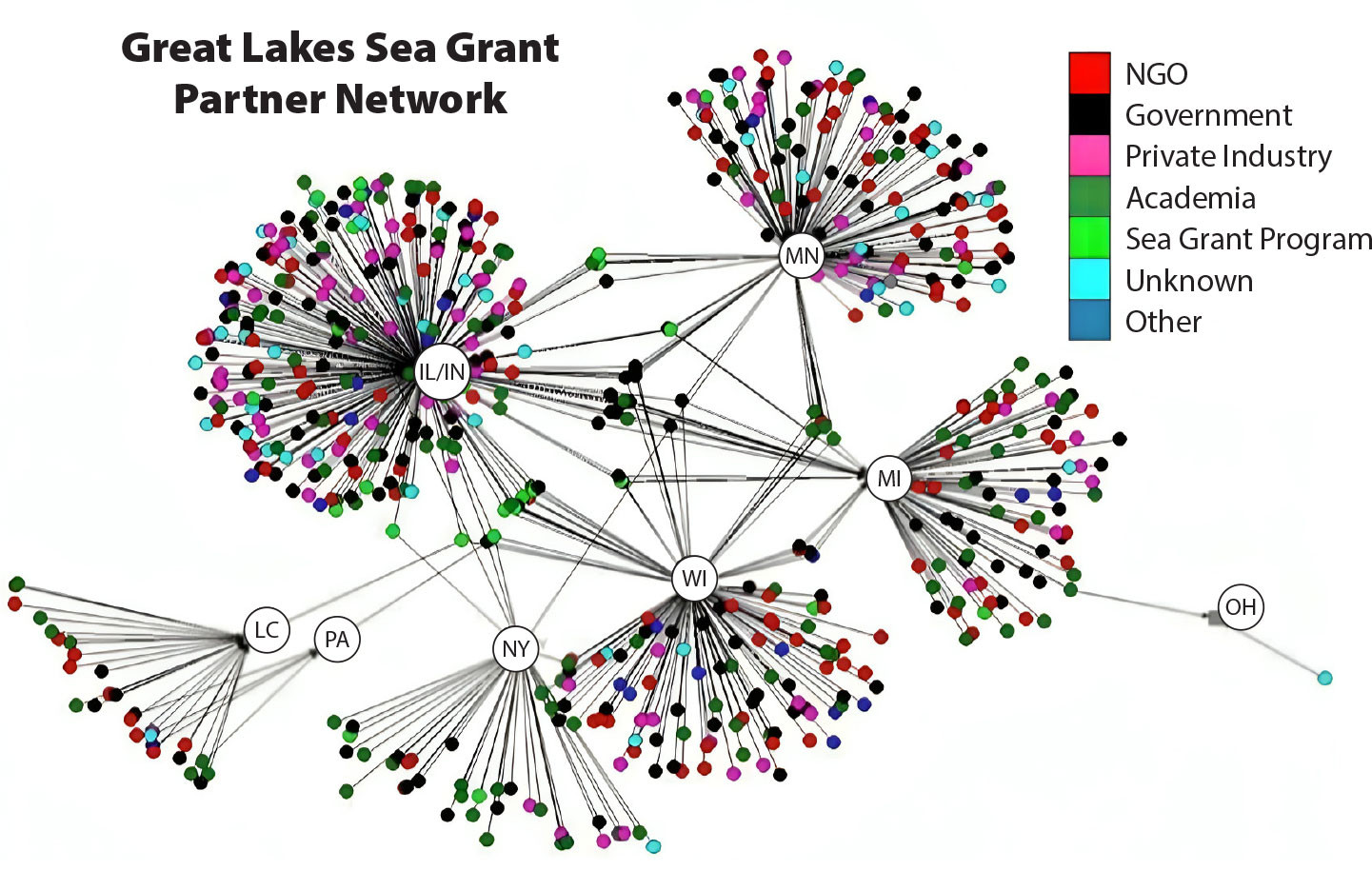
FIGURE 5. Sea Grant programs are often the nodes that connect large networks of people, institutions, and programs, as illustrated by this partner network map for the US Great Lakes region. The partners include government, private industry, academic, and nonprofit organizations in New York (NY), Pennsylvania (PA), Michigan (MI), Minnesota (MN), Illinois/Indiana (IL/IN), Wisconsin (WI), Ohio (OH), and Lake Champlain (LC). Figure courtesy of C. Ellis, A. McCarty, and E. Rohring, presented at Sea Grant Week 2016. > High res figure
|
For example, Virginia Sea Grant convenes the quarterly Hampton Roads Sea Level Rise and Flooding Adaptation Forum, and Delaware Sea Grant hosts the annual Summit of the Resilient and Sustainable Communities League. These meetings bring together local government staff with academic researchers, state and federal agency staff, nongovernmental organizations, and the private sector to share innovative practices, identify research needs, discuss policy and regulatory challenges, and collaborate on projects. Similarly, California Sea Grant co-chairs the Humboldt Sea Level Rise Initiative that has led to multiple collaborations and research endeavors, including land re-appropriation initiatives with coastal tribes (Richmond et al., 2023). The North Carolina Policy Collaboratory, led by North Carolina Sea Grant, was established to facilitate the dissemination of policy and research expertise for practical use by state and local governments, with the goal of assisting communities and state agencies to identify, evaluate, and implement strategies to improve resilience. The collaboration has directly influenced the allocation of approximately $45 million by the North Carolina General Assembly for flood mitigation grants and program development.
In some cases, Sea Grant specializes in connecting and convening work between federal agencies and state or local adaptation efforts. For example, the US Department of Defense (DOD) has increased its investment in coastal resilience in response to extreme weather and climate change impacts affecting DOD installations and their associated communities. A dedicated Sea Grant Coastal Resilience DOD Liaison hosted at Georgia Sea Grant facilitates connections between Sea Grant and DOD programs. Sea Grant extension professionals are serving as partners to the DOD by connecting science, communications, ecological restoration, and community engagement expertise from Rhode Island to Hawai‘i. For example, New Jersey Sea Grant partnered with Naval Weapons Station Earle, local government, and nongovernmental organizations to plan adaptation projections in communities impacted by Superstorm Sandy, and this group has secured over $3 million to implement those projects. Rhode Island Sea Grant connected emergency managers, planners, and researchers to develop flood modeling to assess critical infrastructure in Naval Station Newport and in surrounding municipalities. Identifying infrastructure and evacuation vulnerabilities positioned the partners for future funding by prioritizing needs that are shared by the DOD and communities.
Building Capacity Within Communities
Place-based programs and people and continuous engagement strategies facilitate an ongoing process of needs assessment within US coastal communities and provide insights about barriers to adaptation. Community capacity is almost always identified as the single largest limitation to adaptation, and in response, many Sea Grant programs emphasize capacity building. These efforts support communities by making information and expertise more accessible, building consensus on best practices, developing a climate-ready workforce, creating partner networks, providing resources and tools that inform policy and decision-making, and supporting grant writing and fundraising for local governments, tribes, or other entities.
In Southern California, USC Sea Grant helps coastal communities build capacity for regional analysis and implementation of adaptation strategies. Workshops and webinars link community planners directly to the best available science and modeling. In Manhattan Beach, USC Sea Grant consultation on their local coastal program led to design, community buy-in, and implementation of sand dunes to protect vulnerable infrastructure. As another example, various Sea Grant programs work to facilitate access to the Community Rating System (CRS) managed by the Federal Emergency Management Agency (FEMA). The CRS allows communities to implement flood risk reduction measures and receive discounts on flood insurance premiums, thereby reducing their overall flooding burden. Woods Hole Sea Grant and Cape Cod Cooperative Extension developed a regional support model for helping communities implement flood mitigation best practices and apply for the CRS. With continued assistance that aims to increase capacity and improve community CRS scores over time, policyholders in Barnstable County, Massachusetts, save ~$420,000 each year on their flood insurance premiums while increasing both their resilience to floods and their local knowledge of best practices. In another model, the Sustainable Southeast Partnership (SSP), supported by Alaska Sea Grant, is working to build cultural, ecological, and economic prosperity in Southeast Alaska through a diverse and inclusive partnership with representatives from tribal governments and community-based organizations, including businesses. The SSP is fostering community well-being in communities by focusing on economic development, including cultural and social sustainability. By including diverse organizations in problem-solving partnerships, community priorities can be addressed with greater participation, cooperation, trust, and shared knowledge.
Many programs emphasize workforce development and environmental literacy to build community capacity. Puerto Rico Sea Grant, for example, develops bilingual climate change curricular materials for teachers that are available in print and electronic formats. Similarly, Delaware Sea Grant partners with Delaware Technical Community College campuses and industry, nonprofits, and municipalities to offer students hands-on experience in designing, constructing, and maintaining green infrastructure projects, as well as professional development through semester-long, cohort-style, paid internships. Many of the participating students have backgrounds in engineering or construction but have never been exposed to nature-based designs and their relevance to coastal community resilience. Florida Sea Grant and Mississippi-Alabama Sea Grant run a similar program that trains marine contractors and environmental professionals in the implementation of living shorelines as green, nature-based alternatives to traditional gray infrastructure such as seawalls, bulkheads, and revetments (Martin et al., 2024, in this issue). In 2021, 36 private Florida businesses acquired new skills in living shoreline practices, supporting 44 jobs with an estimated economic impact of $3–$4 million.
Implementing Resilience Projects
The application of the research to solve problems strategy and the place-based people and programs strategy often means that Sea Grant professionals are in ideal positions to support (Figure 6) or lead the development and implementation of on-the-ground projects that enhance resilience in coastal communities. In particular, nature-based designs along a shoreline or in adjacent watersheds can not only protect coastal communities but also have ecological, water quality, recreational, and carbon sequestration benefits.
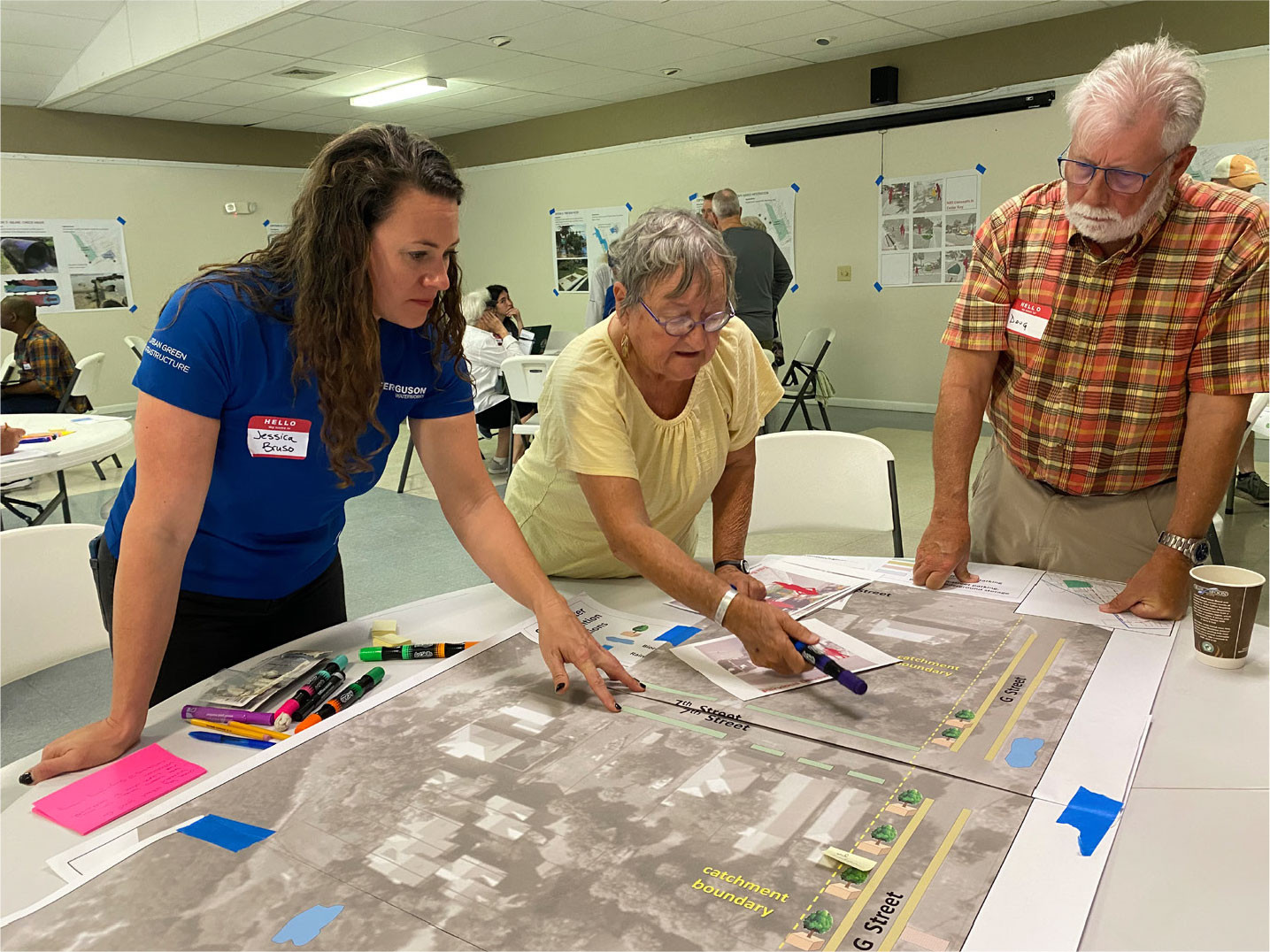
FIGURE 6. Florida Sea Grant and its partners convened residents and community leaders to co-design green stormwater and living shoreline projects for Cedar Key, a small, rural town in an underserved area of Florida’s coast. Photo courtesy of Savanna Barry, Florida Sea Grant. > High res figure
|
In Washington State, the Sea Grant program convened a team of restoration practitioners and engineers after a severe storm flooded multiple homes on the Strait of Juan de Fuca, which led to the design and construction of an innovative soft-shore berm that provides flood protection benefits to 15 homes while maintaining beach habitat and access to the shoreline. Similarly, Georgia Sea Grant hosts the Coastal Georgia Rain Garden program, just one of the tools that stormwater management specialists use to partner with property owners and private contractors to help coastal communities build and manage green stormwater infrastructure. The program has recently installed six rain gardens in flood-prone neighborhoods in Brunswick, Georgia, that filter over 203,000 gallons of stormwater runoff annually while reducing flooding that affects nearby homes.
Delaware Sea Grant served as the project coordinator in the development of a nature-based investment strategy for the Mispillion and Cedar Creek watersheds. Since the investment strategy was completed, two towns within the watershed have received an additional $325,000 in technical assistance for project implementation that includes not only flood-risk reduction elements but also other benefits, including a continuous bike trail. In soup-to-nuts planning and implementation of a nature-based solution, Mississippi-Alabama Sea Grant is leading a DOD-funded $6.5 million shoreline restoration project designed to protect Keesler Air Force Base and the adjacent community. This Back Bay living shoreline project will install approximately 12,000 feet (3,660 m) of breakwaters and wetlands restoration to a rapidly eroding shoreline to protect a variety of critical assets on the base and in the adjacent community of Biloxi, Mississippi.
Where Do We Go from Here?
The application of the five strategies (Figure 2) to the problems associated with climate change and extreme weather has enabled Sea Grant programs nationally to emerge as important and successful partners with coastal communities. This is evident in substantial federal investments allocated through the National Sea Grant Office to the network for advancing resilient communities and economies and healthy coastal ecosystems. For example, approximately $19.3 million from Congress and matching partner funds have supported Sea Grant coastal resilience activities between 2021 and 2024 toward hazard mitigation and contaminants of emerging concern, among others. In 2021 alone, these Sea Grant programs provided approximately 1,335 resilience trainings to communities, helped 584 communities adopt sustainable development practices, and assisted 285 communities in improving resilience to coastal hazards (Stirling, 2022).
The process of adaptation to climate change on the coast is rapidly shifting, though, driven both by the emergence of climate-related impacts, such as extreme weather and sea level rise, and the growth in private, state, and federal investments in climate resilience and adaptation. With this shifting landscape comes increasing demands on the services offered by Sea Grant programs. For example, in the northern Gulf of Mexico, a jointly hosted extension program involving Mississippi State University, Mississippi-Alabama Sea Grant, and Florida Sea Grant, called PLACE:SLR, has grown in recent years to five full-time staff plus regular rotations of interns and fellows. Despite this growth, the staff of this program finds it difficult to meet demands for support services. This changing landscape offers challenges and opportunities for Sea Grant programs, and we offer four areas in which Sea Grant programs can focus to enhance their existing capacity without significant new additions of funding.
First, Sea Grant should enhance partnerships with federal agencies like NOAA, FEMA, NASA, the US Environmental Protection Agency, and the US Geological Survey. Increasingly, these agencies are working to provide nationally scalable technical information that can be tailored to local needs, and Sea Grant can help communities connect to these coastal and climate change data and tools. Additionally, many of these agencies, and others such as DOD and the US Fish and Wildlife Service, offer funding programs or manage policy initiatives that can support community resilience, and Sea Grant can help communities take advantage of these resources. For example, NASA recently recruited representatives from California, Washington, Georgia, and Mississippi-Alabama Sea Grant to provide input on NASA-funded sea level research and products as part of the NASA Sea Level Change Team Practitioner Consultation Board.
Next, Sea Grant programs will also need to enhance or sustain investments in regional collaborative networks and planning efforts that leverage multiple partners, expertise, and funding sources in order to rapidly translate science innovations for broad application by coastal communities. As an example, the New Jersey Coastal Resilience Collaborative (NJCRC) is a network established to foster sustainable and resilient coastal communities and ecosystems. Organized initially in 2016, the Collaborative has been facilitated by New Jersey Sea Grant since 2019 and has grown to include over 75 member organizations. The NJCRC brings together interested parties and serves as a community of practice for the state while also providing connections for technical assistance. Efforts like these multiply the capacity of Sea Grant programs.
Third, the historical inequities associated with the application of risk reduction measures like flood buy-out programs (Shi et al., 2022), as well as the emerging consensus that community capacity is a key limitation for building coastal resilience (Clavin et al., 2023), suggest that an emphasis on equity will continue to be important to Sea Grant’s coastal resilience initiatives. Doing so will require programs to invest heavily in diversity and inclusion to build trust among disenfranchised communities while also attracting and retaining staff that can comfortably span the boundaries between academic environments and the tapestry of coastal communities and cultures that they serve. For example, Sea Grant extension staff nationally are taking part in funding opportunities to build a climate-ready workforce, which involves providing those with historical barriers to environmental careers the necessary training to access available career opportunities and the chance to help their communities and states with green energy transitions, coastal flooding mitigation, and other climate-related needs.
Finally, Sea Grant programs will need to develop new innovations that extend their existing expertise. In other words, Sea Grant will need to learn how to use what they currently do well for new purposes. For example, Sea Grant programs have long-standing and well-established external funding programs to support coastal and marine science within their respective states. That experience and expertise in managing and administering funding programs could be leveraged to address capacity limitations within coastal communities that are often highlighted as a key limitation for building community resilience.
Sea Grant programs employ five strategies to enhance coordination and collaboration, facilitate the co-production and use of knowledge to inform climate policy decisions, provide technical assistance, and ultimately support the process of adaptation in coastal communities. Sea Grant seeks to effectively integrate its services into the sequence of communication, decision-making, and implementation that supports adaptation. Sea Grant is unique in its size and reach, and sits at an important nexus of academia, government, community decision-making, and coastal industry. Sea Grant-linked initiatives are uniquely positioned to accelerate adaptation to meet the growing scale of climate challenges in US coastal communities.

